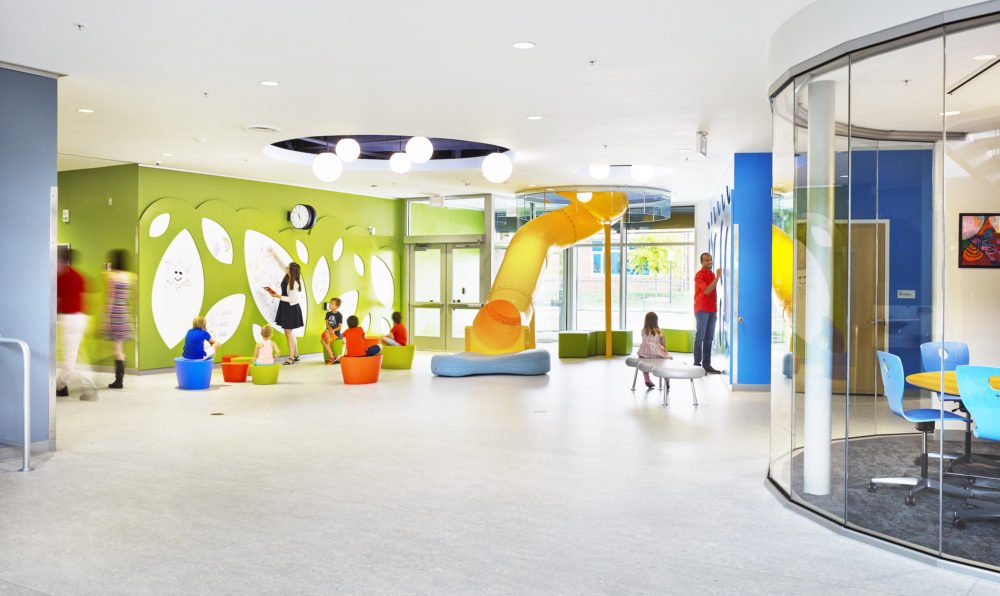A new generation of school buildings is being designed to accommodate a new generation of students. Working with educators, many of today’s architects and interior designers are replacing last century’s staid school buildings and box-like classrooms with architecturally bold designs that are affordable, aesthetic, and energy-efficient.
Gone for good in many districts are rigid rows of heavy steel-framed desks with students facing a lecturer at the front of a neutral-colored classroom white chalk in hand.
“My classroom doesn’t have a front,” says Lauren Rudman, a teacher at Discovery Elementary School in Arlington, Va. “It’s flexible.”
Increasingly, new school interiors include seminar-style rooms with round tables, dry erase whiteboards in hallways, Scrabble and LEGO walls. To create extra space when needed for large internal and external group meetings, new schools usually contain retractable garage doors, foldable partitions, and stackable furniture.
Rudman’s fourth-graders are based in a studio classroom with a glass wall on the corridor intentionally placed across a technology commons area. Within a normal 45-minute class period, Rudman can find herself monitoring three sets of students with some sitting on the window box against the glass wall or on a stool in the commons area while others study at their tables.
“I can interact with one group of students at a small table in my classroom and still keep an eye on students on the other side of the glass,” she says.
Most of Discovery’s classrooms feature flexible furniture including height-adjustable tables, upholstered chairs, beanbags, and carpeted reading steps that provide students with flexibility.
“An appropriate amount of visual openness in a school promotes a culture of collaboration,” says Wyck Knox, lead architect on Discovery’s design team. “Everyone learns in unique ways, in their own preferred environment.”
Knox says there is no wrong way or place to learn although many of today’s architects are challenging the traditional definition of a learning space as defined by four walls.
“Each learning space should be allowed the opportunity to be something greater than its box,” he says. “Creativity is showcased in spaces that are joyful, bright, and honor the learner and educator.”
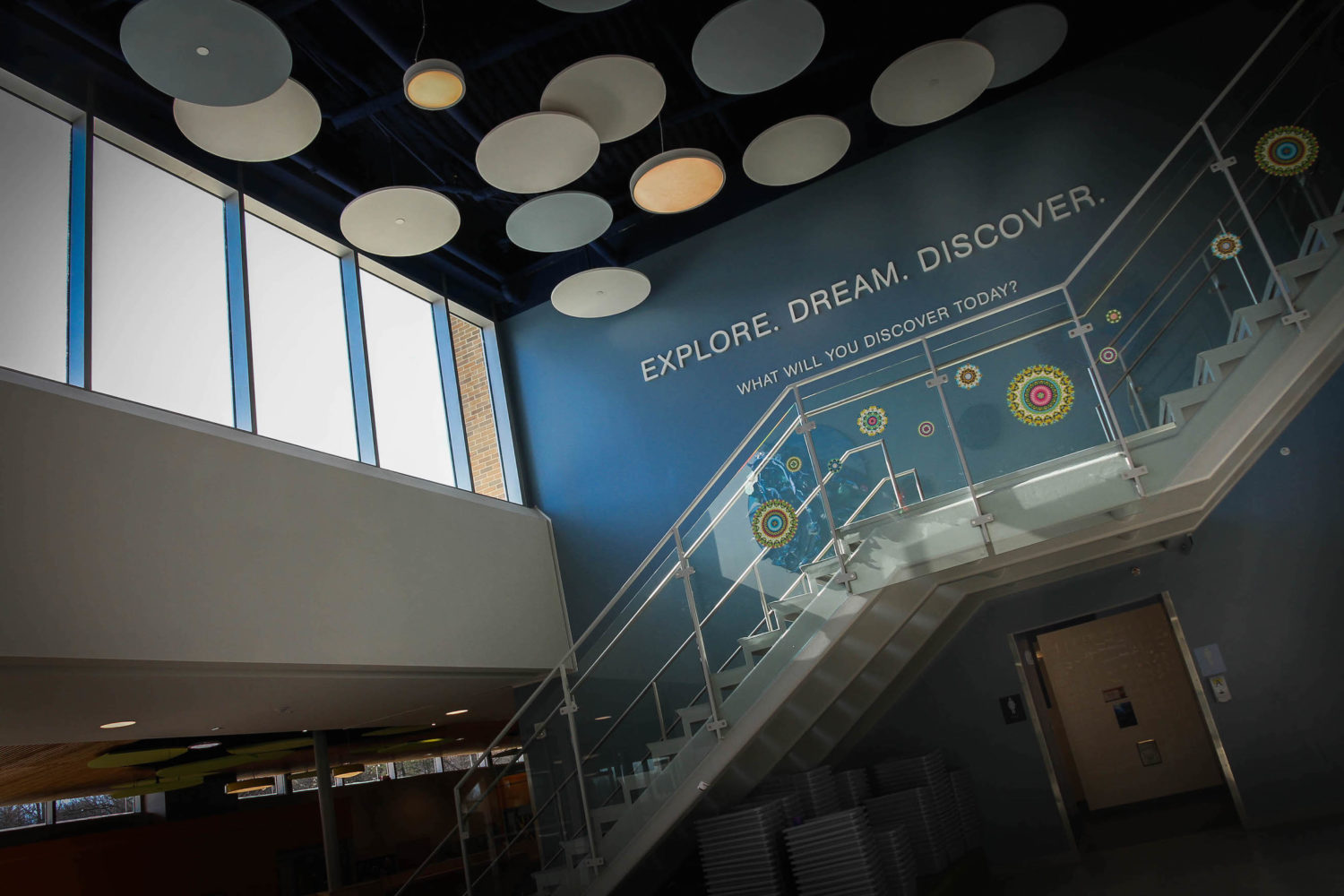 Discovery School in Arlington, Va. (photo: Luis Gomez)
Discovery School in Arlington, Va. (photo: Luis Gomez)
Near Salt Lake City, in Woods Cross, Utah, Odyssey Elementary School incorporates into its teaching pedagogy the theme of "Bodies in Motion: The Animal Kingdom." Classrooms are organized between four wings, called “habitats.” Each habitat has a name: swim, run, jump, fly.
“The idea was to create a fun environment students want to attend everyday,” says John Oderda, an architect who oversaw the construction of Odyssey, which opened its doors in 2014. “The one animal that can do all of these things is the human animal.”
“An appropriate amount of visual openness in a school promotes a culture of collaboration. Everyone learns in unique ways, in their own preferred environment.” - Wyck Knox, lead architect on Discovery’s design team.
Although education funding at all levels has been flat in recent years, the education construction sector remains one of the biggest in the category of nonresidential construction, according to the U.S. Census Bureau. However, for some officials leading our nation’s 13,515 school districts, there does not seem to be a need to start from scratch with a bold new building. Instead of a full facelift, some school administrators choose to nip and tuck one room at a time.
For example, Roosevelt Middle School in San Francisco won a grant that went toward updating the design and function of its cafeteria. In Chandler, Ariz., a teacher won a grant to renovate Santan Elementary School’s outdated school lounge.
Still, the Holy Grail of school cosmetic surgery at the moment seems to be the installation of solar panels to help achieve net zero energy cost. While only a handful of schools do so right now, says Knox, the percentage of new schools pursuing this objective is rapidly rising.
“Enough projects, specifically public schools, have demonstrated that achieving net zero cost is possible without breaking the bank,” he says. “Having more zero energy buildings is critical for the environment, but zero energy schools protect that most precious of tax dollars – annual operating costs of schools.”
Oderda agrees: “Good design doesn’t have to cost anymore than bad design. You have to put something on the wall. A colored wall doesn’t cost more than a white wall.”
The Art of Discovery
Nestled in a sleepy residential area of Arlington, Va., the radiant Discovery Elementary School rests securely atop a hill. Tidy rows of slopeside trees add beauty and cover to the two-story building. In front and along the tiered landscape, a long stonewall conceals several play areas, vegetable gardens, and water basins connected to an underground geothermal system that reduces energy costs.
While outdoor areas are shaded from the quiet streets below, the school’s cerebral interior is an open book. Every nook and cranny shines as a manifesto of exploration, imagination, and discovery.
“It’s more like a children’s museum inside, where the walls are interactive,” says Principal Erin Russo.
At Discovery, the walls, floors and ceilings thematically communicate the progress students make from one grade to the next. The first floor design scheme centers on earth ecosystems. Terrestrial shapes systematically orient kindergarten students as Backyard Adventurers. Upon entering first grade, students become Forest Trailblazers then Ocean Navigators in grade two.
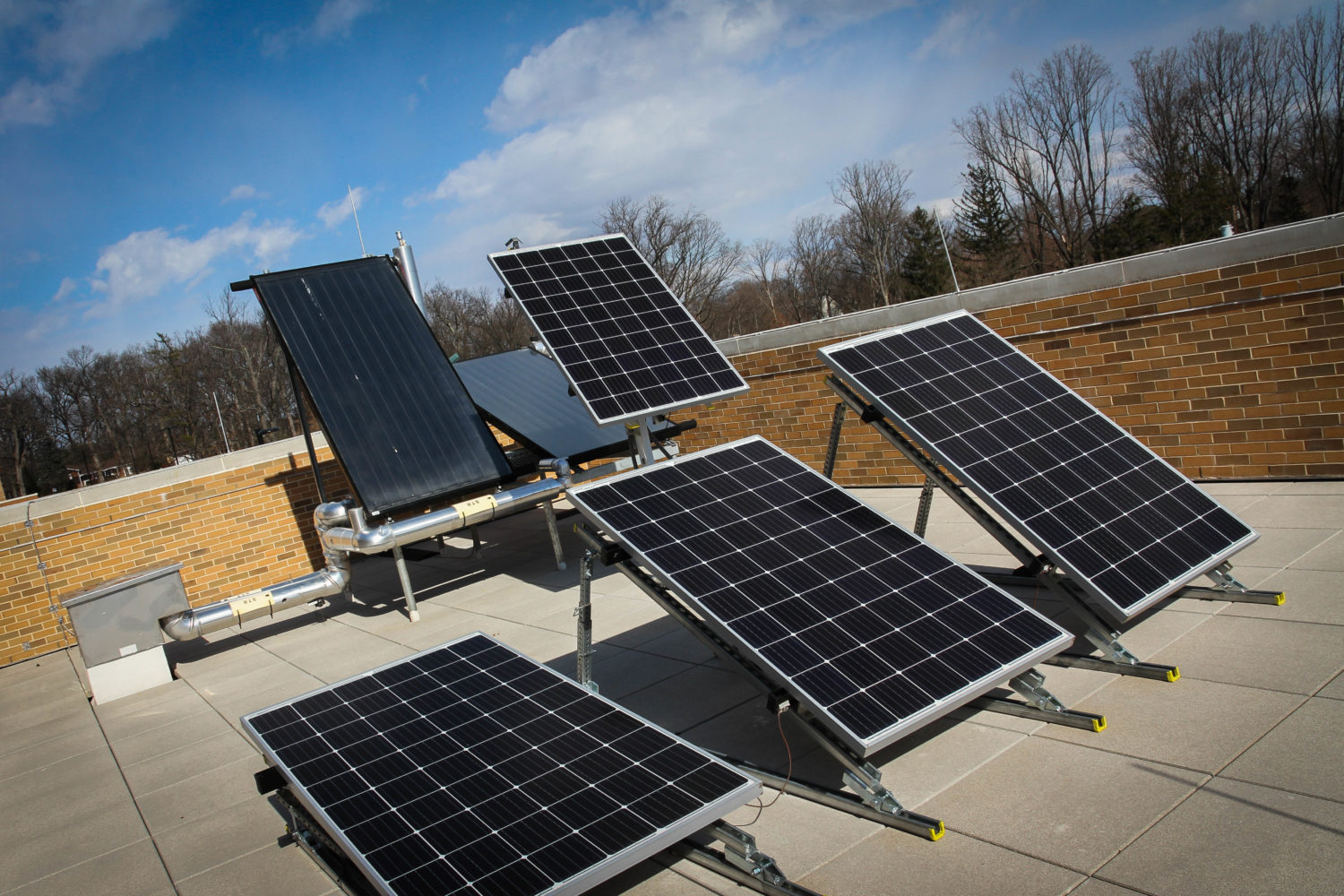 Discovery School incorporates many energy conserving measures, including the approximately 1700 solar panels on the school’s roof. (photo: Luis Gomez)
Discovery School incorporates many energy conserving measures, including the approximately 1700 solar panels on the school’s roof. (photo: Luis Gomez)
The celestial-themed second floor identifies with the sky and solar system. At this elevation, third-graders are categorized as Atmosphere Aviators, fourth-graders as Solar System Pioneers, and fifth-graders as Galaxy Voyagers. When students start school, they sign their name on magnetic disc attached to the entry wall and watch over the years as their disc moves down the wall.
“This approach gives students a grade-level identity while also engaging them as they interact with the building,” says Russo.
Before Discovery opened in 2015, students from Arlington Public Schools who would be attending were asked at public meetings to vote on names for the school and mascot. The “Discovery Explorers” mascot name pays tribute to John Glenn, who lived near the school site when he became the first American to orbit the earth in 1962. In 1998, while serving in the U.S. Senate, Glenn returned to space on the shuttle Discovery, the school’s namesake.
Serving approximately 650 students, Discovery cost almost $33 million.
A sleek roof canopy runs the length of the school covering outdoor dining and play spaces. More than 1,700 rooftop solar panels and other means account for the school’s net zero energy usage while serving as a lab where students conduct experiments.
“Features like these are designed to create a seamless integration between curriculum, environmental awareness, and energy sustainability,” says Russo.
One of the school’s showstoppers is a large digital dashboard screen located near the entry. The state-of-the-art system tracks Discovery’s lighting, technology, and other energy use in real-time where it is published and accessible to every school device connected to the Internet.
“We use it more as an interactive learning tool for students and teachers,” says Russo. “We want it to motivate them to help the building maintain net zero energy status and create awareness about energy use.”
The Sky’s the Limit for Learning
Art teacher Maria Burke stands beneath a solar skylight portal built into the ceiling.
“It adds light to the room on cloudy days,” says Burke, a member of the Arlington Education Association (AEA).
Natural light also cascades into the room from oversized windows facing south, a deliberate design point that took into consideration solar orientation. Along with Burke’s classroom, interiors on the south side of the building feature bright, sunny colors. The north side of the school features cooler colors such as greens and blues, reflecting the natural hues of moss that grows on the north side of trees.
In her classroom, Burke makes full use of tall wooden shelving to store art supplies. The room includes a retractable garage door that opens up for large-group meetings and three sinks aligned to accommodate more than one student at a time.
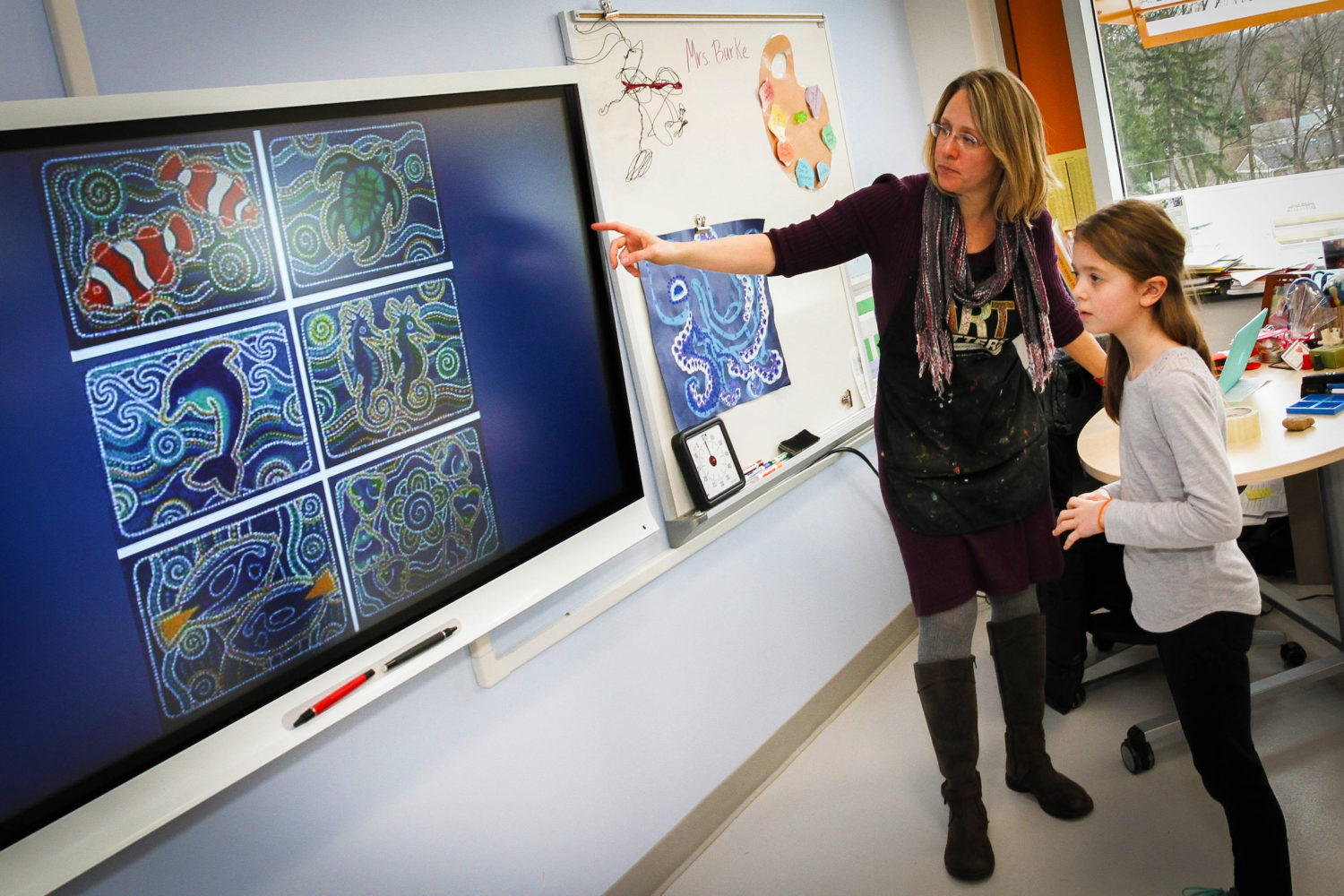 Discovery art teacher Maria Burke with one of her students (photo: Luis Gomez)
Discovery art teacher Maria Burke with one of her students (photo: Luis Gomez)
“It’s a dream classroom,” says Burke, who makes it a point not to clutter her beloved room with gratuitous signs and images. “Students need light and an uncluttered environment to think and create.”
Two unique features of the school are located on the second floor: a bright yellow two-story slide and a glass-enclosed meeting room for teachers fondly referred to as the “fish bowl.”
“An appropriate amount of visual openness in the school promotes a culture of collaboration, because that cross-pollination and creativity is showcased in spaces that are joyful, bright, and honor the learner and educator,” says Knox, executive architect at VMDO Architects.
Net Zero School
Along with promoting themes through innovative design, school districts are increasingly building schools that attempt to reduce energy costs. Davis School District’s Odyssey, for example, has been designated as being the first net zero school building in Utah.
Thanks to 1,200 rooftop solar panels and other means, the two-story building uses less electrical energy of any other school building in the state.
“Ideally, we wanted to generate just as much energy as we need,” says Oderda. “We estimated the school’s energy need when the design process started in 2010 and then designed accordingly.”
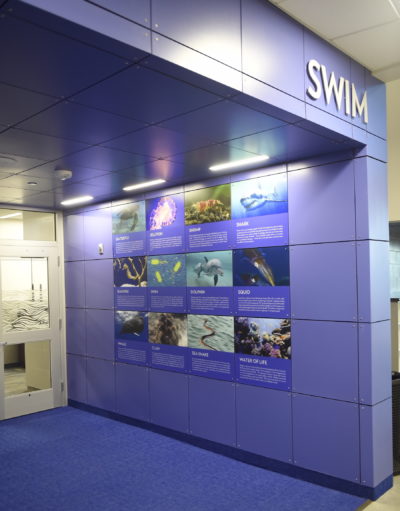 The classrooms at Odyssey Elementary School in Woods Cross, UT are organized between four wings, called “habitats.” Each habitat has a name: swim, run, jump, fly.
The classrooms at Odyssey Elementary School in Woods Cross, UT are organized between four wings, called “habitats.” Each habitat has a name: swim, run, jump, fly.
The school has also achieved Leadership in Energy and Environmental Design (LEED) Gold certification, which is one of the most popular green building certification programs used worldwide.
“The school uses low-flow water fixtures,” says Oderda. Water conservation is also incorporated outdoors with the use of sensors in the school’s sprinkler system.
The hallmark of poor design, says Oderda, is obnoxious signage.
“We try to do things as visually as possible where you don’t have chunky arrows telling you where to go,” he says.
At Odyssey, its 650 students and multiple visitors can easily find their way around the two-story school by orienting themselves to six colors clearly laid out on the floor and walls.
The walls in the open cafeteria and auditorium area are decorated with large banners containing images of hikers, rock climbers, hang gliders and surfers. Inspirational quotes from J.K. Rowling, Thomas Jefferson, Dr. Seuss, and others line second-floor walls and doorways.
The Bodies in Motion theme encourages exercise and enjoying the outdoors, Oderda says. Childhood obesity was a front-page topic when the school was being planned beginning in 2010.
“The movement theme was a way to combat obesity,” Oderda says. “We try to present information at a level students will understand without talking down to them.”
At the design phase, the architects also considered the life cycle of the building and how it could expand with the times. Instead of tearing down walls, building doors and walls are easily removed for reuse instead of demolition.
“We tried to make the building as flexible as possible,” say Oderda, of Salt Lake City-based VCBO Architects.
The curved exterior of the building has sparkling blue reflective metal panels that evoke water in motion and reference the scales of a fish.
“The curved design makes it look like the building is moving,” says Oderda. “The building’s exterior is in sync with the school’s theme -- movement.”
Physical design features like those found at Odyssey and Discovery might be architecturally stunning but they are above all else student-centered. While solar panels and digital dashboards may be all the rage in education construction, well-designed new schools seem to convey the simple message that society values education.
Photo credit (top image): VMDO Architects
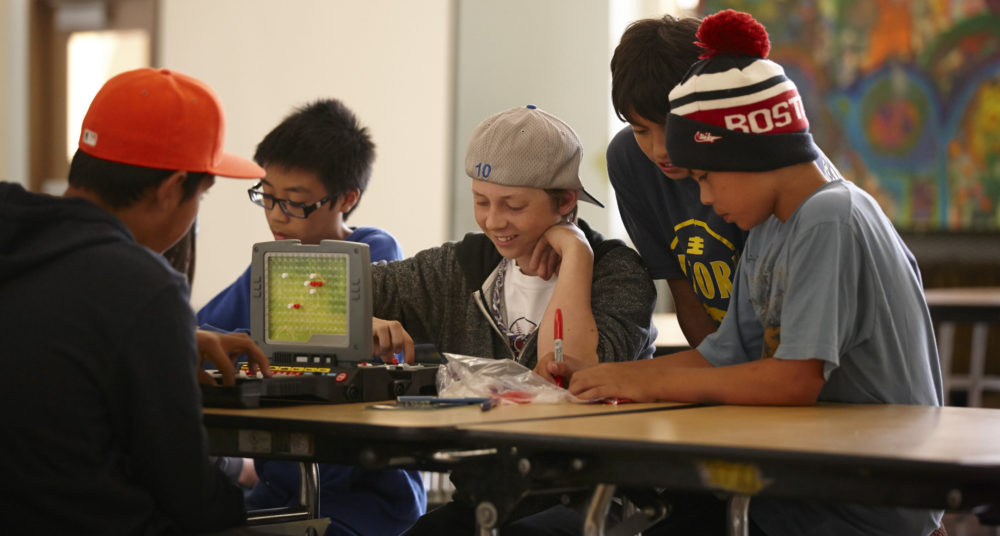 Students hang out in Roosevelt Elementary's new cafeteria. (photo: courtesy of IDEO)
Students hang out in Roosevelt Elementary's new cafeteria. (photo: courtesy of IDEO)
California Cool: A Reinvented School Cafeteria
Designing school cafeterias as places where students might voluntarily choose to dine can be a challenge. In 2013, officials with San Francisco Unified School District (SFUSD) hired global design firm Ideo to help them determine how to get students more excited about eating at school.
After a six-month discovery process involving more than 1,300 district students, families, educators, cafeteria workers, and administrators, designers learned among other things that during lunchtime kids crave to be with friends.
“School cafeterias weren’t originally designed to make hanging out with friends a priority,” says Ideo’s Sandy Speicher. “Kids were waiting in long lines to assemble their food trays, and many students were skipping that process to get to the ultimate goal of social time.”
In addition to considering how to entice students to dine in, designers were also challenged by cost efficiencies and operations.
“One important component of the new design strategy was to create distributed points of sale so that students could access meals in multiple places in order to avoid long lines,” says Gentle Blythe, SFUSD chief communications officer.
Today, in place of dreary rows of long tables, stark fluorescent lighting, and long food lines, you will find outdoor mobile carts serving sandwiches, a Chill Out area with fluffy couches and bright yellow chairs, and family-style round tables, each with an adult leader and student-captain responsible for cleaning up.
“The new cafeteria makes for a comfortable, efficient environment,” says David Watson, who has taught English at Roosevelt for 12 years. “It encourages socializing but also offers quieter areas for students who might want to just sit and read.”
District officials say the cafeteria redesign project is an ongoing process where student priorities will remain front and center. For upcoming schools, the design team will involve students in the designing process so they can assume more ownership of the space.
